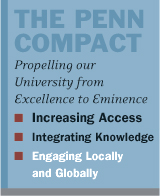A new vision of local and global engagement.
By Amy Gutmann

countries. Rather, it is a collaborative,
integrated approach to teaching, research,
campus development, and economic activity.
My walking path to College Hall each morning takes me onto Locust Walk all the way to College Green. I enjoy the walk’s aesthetic charms, as well as my lively exchanges with many of the students, faculty, and staff who make Locust Walk a great cosmopolitan thoroughfare.
I occasionally linger near the Compass at the intersection of 37th and Locust Walk. (I know better than to walk on it!) Viewing the 360-degree panorama from the Compass, one can easily take for granted the dramatic physical transformation of the Penn campus over the past century. Yet, many of our alumni can recall the time when Locust Walk was Locust Street, when University Square was a surface parking lot, when the Furness Building was Penn’s only library, and when Blanche P. Levy Park was the old college green. Many other projects undertaken more than a century ago, including the construction of the Quadrangle, the University Museum, and the Engineering campus, drove Penn to national excellence and began to shape its local and global outlook.
As we drive toward eminence under the Penn Compact, we are building on a solid foundation to create a newvision of local and global engagement. It is not an exercise in noblesse oblige, where we export enlightenment to communities and countries. Rather, it is a collaborative, integrated approach to teaching, research, campus development, and economic activity that will boost Penn’s capacity to serve our society and humanity.
We will embrace this approach most notably in planning the forthcoming 14-acre expansion of our campus to the Schuylkill River, which, along with the construction of a new Center for Advanced Medicine, the proposed redevelopment of the U.S. Post Office properties, and other major physical and programmatic changes, will propel Penn to global eminence and redefine the way we engage the city of Philadelphia and the rest of the world.
Imagine with me the transformation of surface lots, fallow buildings, and eyesores into a neighborhood featuring beautiful parks and recreational facilities, new shops and restaurants, lively arts venues, gleaming buildings for teaching and research at Penn, and even a new College House.
Picture an inviting gateway to Penn along the Schuylkill River that seamlessly connects the University and West Philadelphia to Center City. Imagine strolling all the way to the river along pedestrian walkways.
Imagine Philadelphia’s cosmopolitan center of gravity shifting toward University City as Penn partners with the School District to establish a magnet public high school whose focus on international studies and languages will better prepare students to succeed in a global economy. Think about the jobs and entrepreneurial opportunities that this expansion will create for local residents as it catapults the Philadelphia region into the global forefront of the knowledge economy.
Imagine a state-of-the-art Center for Advanced Medicine, designed by the world renowned architect Rafael Viñoly, which will consolidate services in a beautiful new patient-centered environment for the three fastest growing areas of medicine: cancer, cardiovascular, and outpatient surgery.
This is but one snapshot of Penn’s future. There will be more great pictures to take as we develop a comprehensive vision of Penn’s future. Over the course of this academic year, a University committee will draw on the energies, creativity, and talents of Penn faculty, students, alumni, and staff, as well as on public citizens and neighborhood groups, to produce a revised campus master plan that will help us secure Penn’s future as the premier research university for the next century.
At the same time, we will continue to build on ties with our friends and partners in West Philadelphia that have made Penn a national model for local engagement. And we will work to ensure that long-time neighborhood residents and their children share more fully and equitably in the benefits of our eastward campus expansion and progress throughout the region.
As we develop our local campus master plan, we will also embark on creating a global campus plan that reflects Penn’s perspective that we are very much in the world—a world of local communities that we engage as full partners in the quest to create new knowledge and enrich the lives of our fellow human beings. Our global campus will not consist of buildings, centers, and parks. Rather, it will engage Penn alumni throughout the world in the pursuit of new ideas and solutions to the pressing issues of our time. It will attract more international scholars and practitioners to give the Penn campus a more dynamic global perspective. And we will create ever more robust models of integrated global teaching, research, and practice across our schools, building on the successes of the Huntsman Program in International Studies and Business and the Lauder Institute, which integrate management education with international studies and with languages for undergraduate and graduate students, respectively.
This year, I will be visiting Penn alumni in India, China, Japan, and Singapore. And I will seek new ways to stay in closer touch with alumni throughout the world, from Philadelphia to the Philippines. I invite all of you to share your perspectives on local and global engagement. After all, this is your campus that we are planning to expand. And this is your great University that is reaching out to local communities throughout the world. Working together, we can transform Penn not only into a premier global University, but also into a greater force for good in our society and our world.

